Literature Review: Strategies for Building Organisational Commitment
VerifiedAdded on 2023/01/19
|9
|2673
|34
Literature Review
AI Summary
This literature review delves into the multifaceted concept of organisational commitment, exploring its definition, types, and influencing factors. It examines affective, normative, and continuance commitment, highlighting their impact on employee behavior and organizational goals. The review investigates the roles of gender and age in shaping commitment levels, alongside the crucial relationship between job satisfaction and organisational commitment. Furthermore, it emphasizes the significance of high-commitment Human Resource Management (HC-HRM) practices in fostering employee engagement and dedication. The synthesis of various research findings provides a comprehensive understanding of strategies for building and sustaining strong organisational commitment, crucial for enhanced employee retention and organizational success. The review draws from various academic journal articles to provide a detailed analysis.
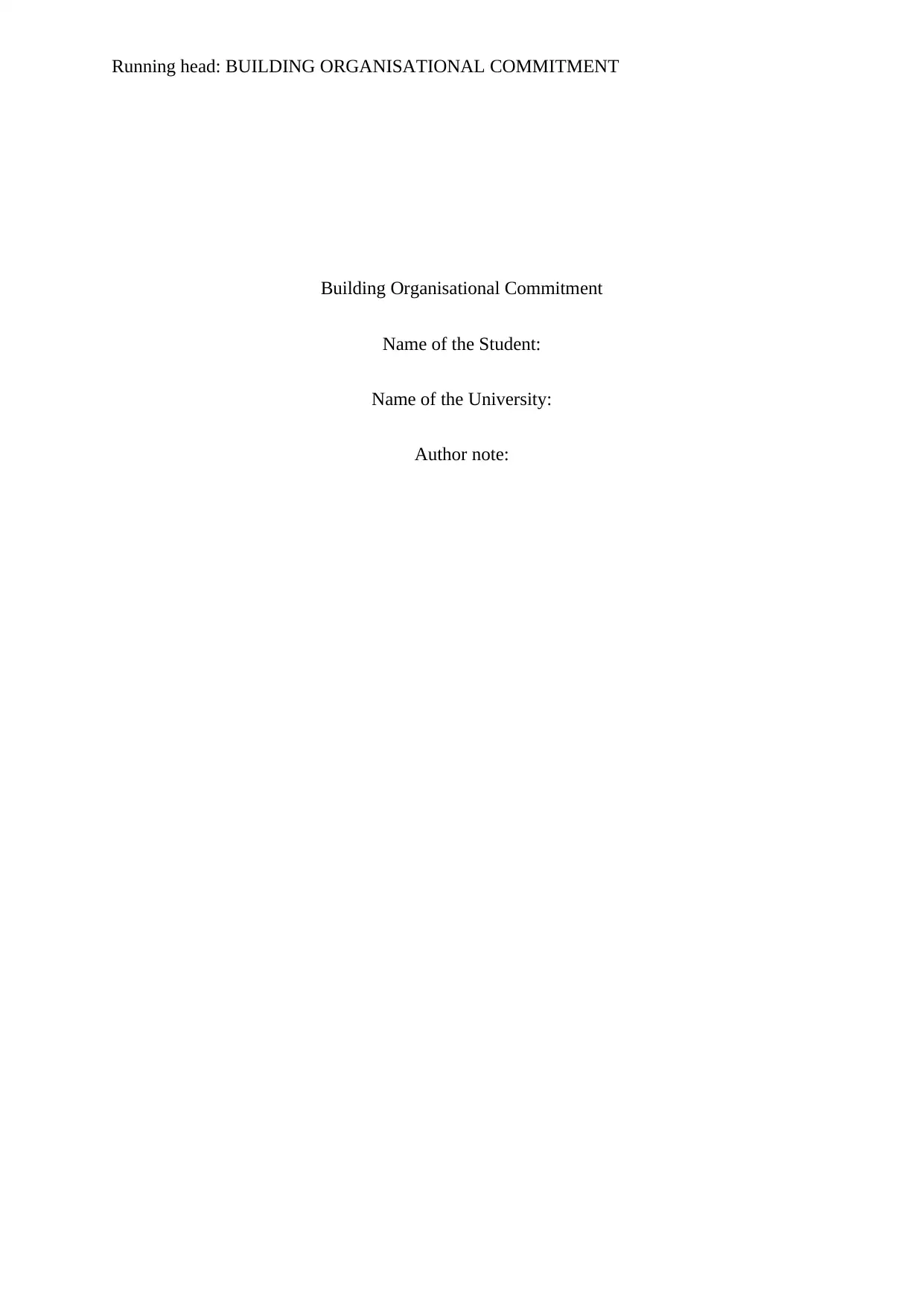
Running head: BUILDING ORGANISATIONAL COMMITMENT
Building Organisational Commitment
Name of the Student:
Name of the University:
Author note:
Building Organisational Commitment
Name of the Student:
Name of the University:
Author note:
Paraphrase This Document
Need a fresh take? Get an instant paraphrase of this document with our AI Paraphraser
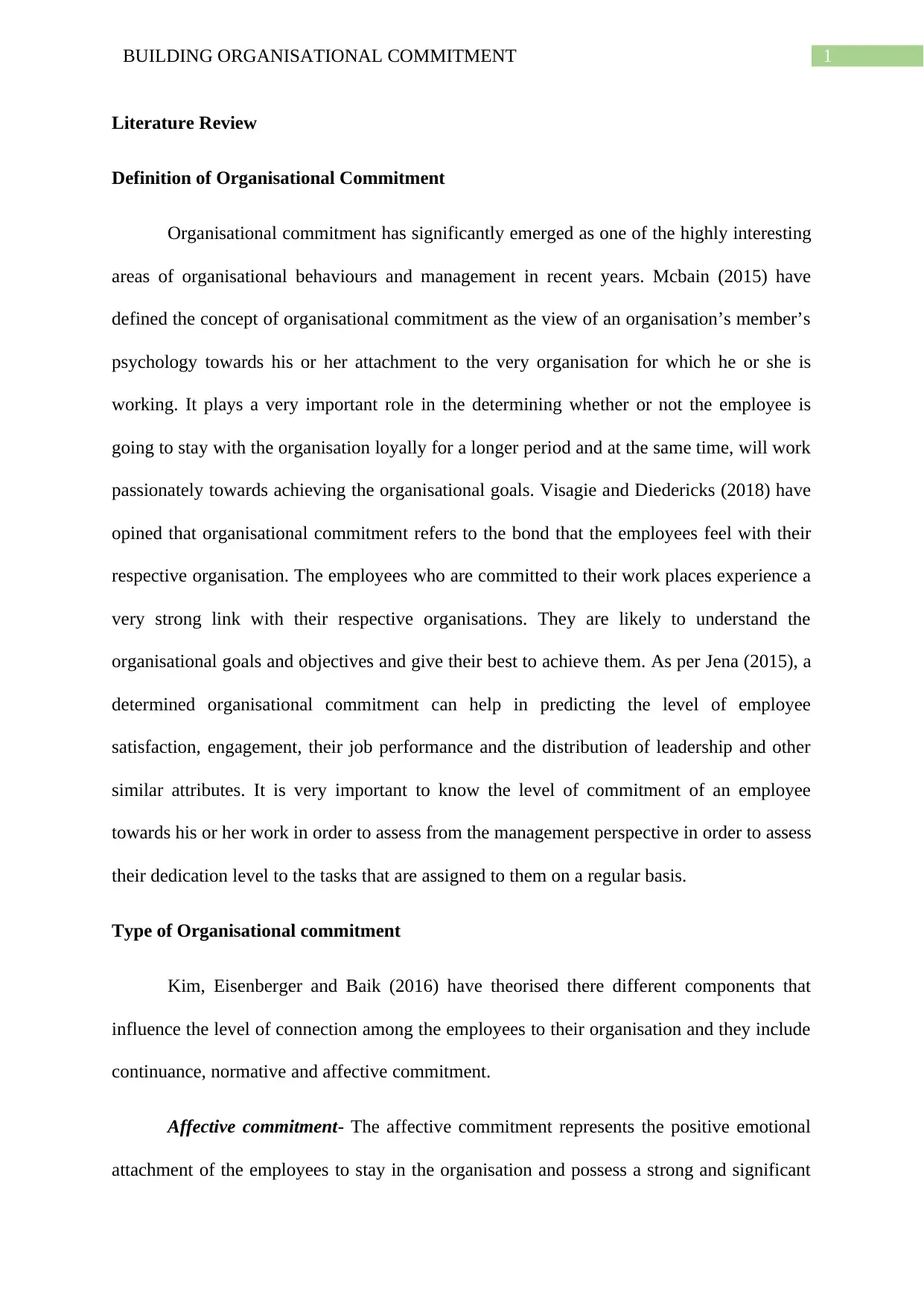
1BUILDING ORGANISATIONAL COMMITMENT
Literature Review
Definition of Organisational Commitment
Organisational commitment has significantly emerged as one of the highly interesting
areas of organisational behaviours and management in recent years. Mcbain (2015) have
defined the concept of organisational commitment as the view of an organisation’s member’s
psychology towards his or her attachment to the very organisation for which he or she is
working. It plays a very important role in the determining whether or not the employee is
going to stay with the organisation loyally for a longer period and at the same time, will work
passionately towards achieving the organisational goals. Visagie and Diedericks (2018) have
opined that organisational commitment refers to the bond that the employees feel with their
respective organisation. The employees who are committed to their work places experience a
very strong link with their respective organisations. They are likely to understand the
organisational goals and objectives and give their best to achieve them. As per Jena (2015), a
determined organisational commitment can help in predicting the level of employee
satisfaction, engagement, their job performance and the distribution of leadership and other
similar attributes. It is very important to know the level of commitment of an employee
towards his or her work in order to assess from the management perspective in order to assess
their dedication level to the tasks that are assigned to them on a regular basis.
Type of Organisational commitment
Kim, Eisenberger and Baik (2016) have theorised there different components that
influence the level of connection among the employees to their organisation and they include
continuance, normative and affective commitment.
Affective commitment- The affective commitment represents the positive emotional
attachment of the employees to stay in the organisation and possess a strong and significant
Literature Review
Definition of Organisational Commitment
Organisational commitment has significantly emerged as one of the highly interesting
areas of organisational behaviours and management in recent years. Mcbain (2015) have
defined the concept of organisational commitment as the view of an organisation’s member’s
psychology towards his or her attachment to the very organisation for which he or she is
working. It plays a very important role in the determining whether or not the employee is
going to stay with the organisation loyally for a longer period and at the same time, will work
passionately towards achieving the organisational goals. Visagie and Diedericks (2018) have
opined that organisational commitment refers to the bond that the employees feel with their
respective organisation. The employees who are committed to their work places experience a
very strong link with their respective organisations. They are likely to understand the
organisational goals and objectives and give their best to achieve them. As per Jena (2015), a
determined organisational commitment can help in predicting the level of employee
satisfaction, engagement, their job performance and the distribution of leadership and other
similar attributes. It is very important to know the level of commitment of an employee
towards his or her work in order to assess from the management perspective in order to assess
their dedication level to the tasks that are assigned to them on a regular basis.
Type of Organisational commitment
Kim, Eisenberger and Baik (2016) have theorised there different components that
influence the level of connection among the employees to their organisation and they include
continuance, normative and affective commitment.
Affective commitment- The affective commitment represents the positive emotional
attachment of the employees to stay in the organisation and possess a strong and significant
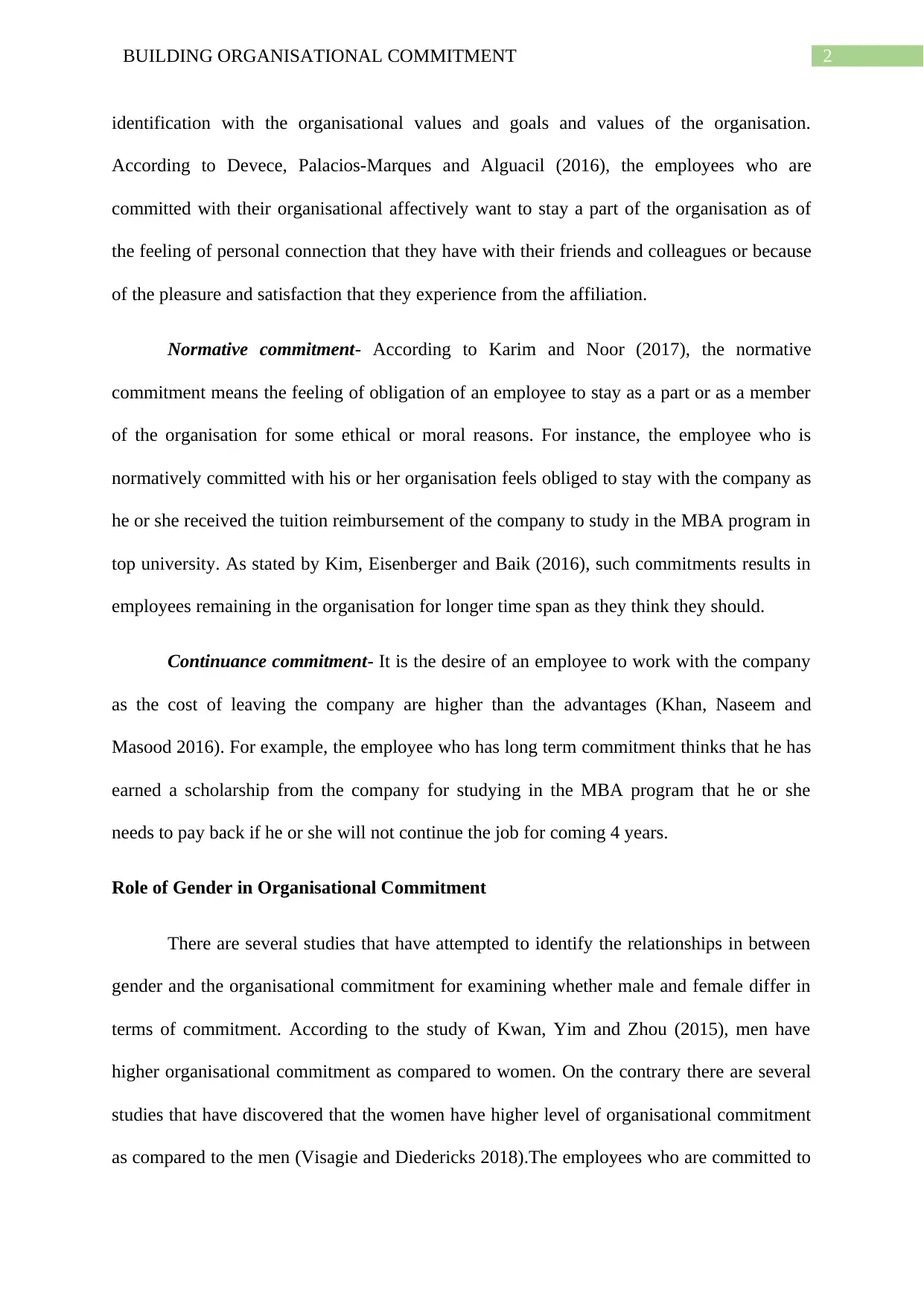
2BUILDING ORGANISATIONAL COMMITMENT
identification with the organisational values and goals and values of the organisation.
According to Devece, Palacios-Marques and Alguacil (2016), the employees who are
committed with their organisational affectively want to stay a part of the organisation as of
the feeling of personal connection that they have with their friends and colleagues or because
of the pleasure and satisfaction that they experience from the affiliation.
Normative commitment- According to Karim and Noor (2017), the normative
commitment means the feeling of obligation of an employee to stay as a part or as a member
of the organisation for some ethical or moral reasons. For instance, the employee who is
normatively committed with his or her organisation feels obliged to stay with the company as
he or she received the tuition reimbursement of the company to study in the MBA program in
top university. As stated by Kim, Eisenberger and Baik (2016), such commitments results in
employees remaining in the organisation for longer time span as they think they should.
Continuance commitment- It is the desire of an employee to work with the company
as the cost of leaving the company are higher than the advantages (Khan, Naseem and
Masood 2016). For example, the employee who has long term commitment thinks that he has
earned a scholarship from the company for studying in the MBA program that he or she
needs to pay back if he or she will not continue the job for coming 4 years.
Role of Gender in Organisational Commitment
There are several studies that have attempted to identify the relationships in between
gender and the organisational commitment for examining whether male and female differ in
terms of commitment. According to the study of Kwan, Yim and Zhou (2015), men have
higher organisational commitment as compared to women. On the contrary there are several
studies that have discovered that the women have higher level of organisational commitment
as compared to the men (Visagie and Diedericks 2018).The employees who are committed to
identification with the organisational values and goals and values of the organisation.
According to Devece, Palacios-Marques and Alguacil (2016), the employees who are
committed with their organisational affectively want to stay a part of the organisation as of
the feeling of personal connection that they have with their friends and colleagues or because
of the pleasure and satisfaction that they experience from the affiliation.
Normative commitment- According to Karim and Noor (2017), the normative
commitment means the feeling of obligation of an employee to stay as a part or as a member
of the organisation for some ethical or moral reasons. For instance, the employee who is
normatively committed with his or her organisation feels obliged to stay with the company as
he or she received the tuition reimbursement of the company to study in the MBA program in
top university. As stated by Kim, Eisenberger and Baik (2016), such commitments results in
employees remaining in the organisation for longer time span as they think they should.
Continuance commitment- It is the desire of an employee to work with the company
as the cost of leaving the company are higher than the advantages (Khan, Naseem and
Masood 2016). For example, the employee who has long term commitment thinks that he has
earned a scholarship from the company for studying in the MBA program that he or she
needs to pay back if he or she will not continue the job for coming 4 years.
Role of Gender in Organisational Commitment
There are several studies that have attempted to identify the relationships in between
gender and the organisational commitment for examining whether male and female differ in
terms of commitment. According to the study of Kwan, Yim and Zhou (2015), men have
higher organisational commitment as compared to women. On the contrary there are several
studies that have discovered that the women have higher level of organisational commitment
as compared to the men (Visagie and Diedericks 2018).The employees who are committed to
⊘ This is a preview!⊘
Do you want full access?
Subscribe today to unlock all pages.

Trusted by 1+ million students worldwide
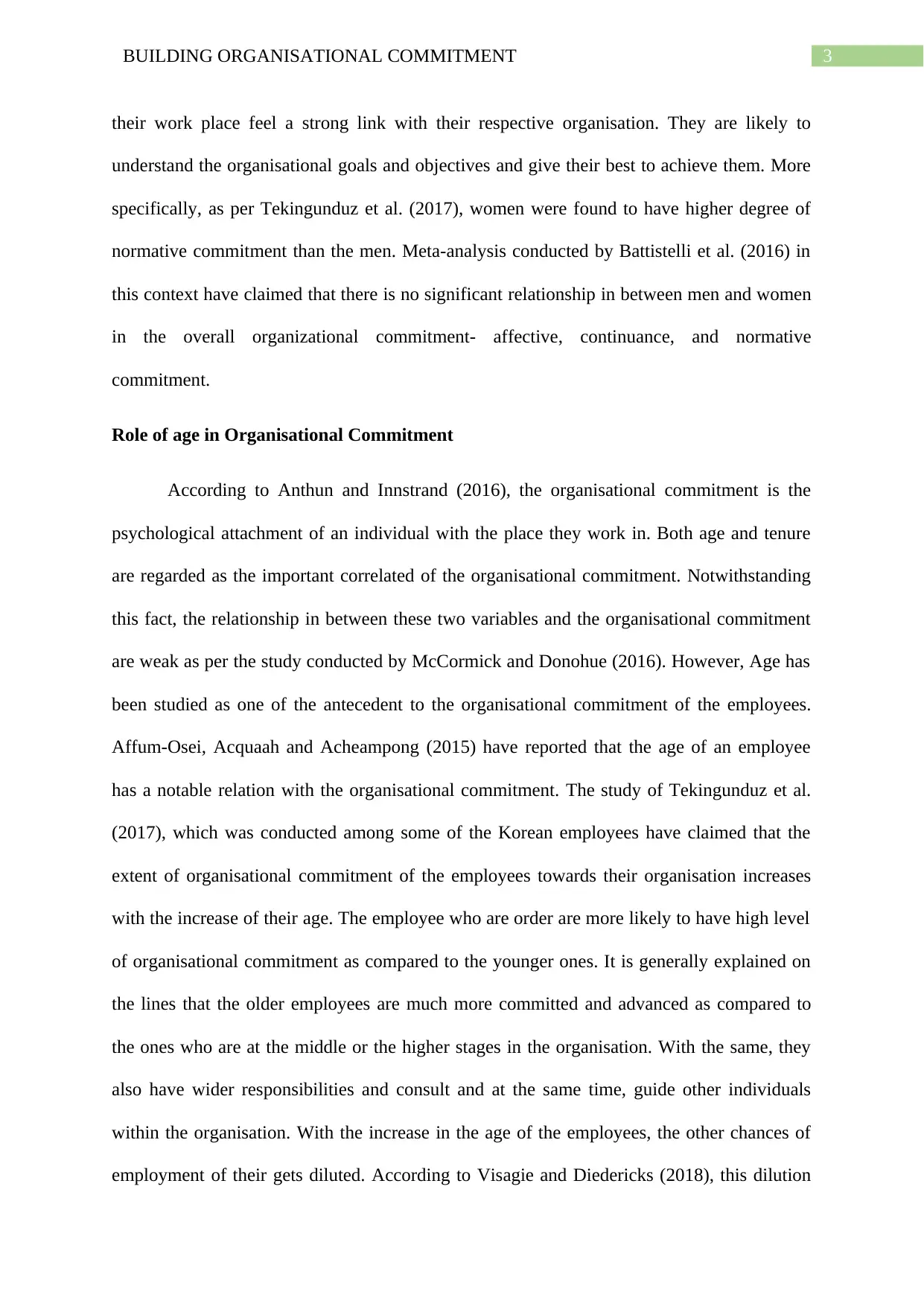
3BUILDING ORGANISATIONAL COMMITMENT
their work place feel a strong link with their respective organisation. They are likely to
understand the organisational goals and objectives and give their best to achieve them. More
specifically, as per Tekingunduz et al. (2017), women were found to have higher degree of
normative commitment than the men. Meta-analysis conducted by Battistelli et al. (2016) in
this context have claimed that there is no significant relationship in between men and women
in the overall organizational commitment- affective, continuance, and normative
commitment.
Role of age in Organisational Commitment
According to Anthun and Innstrand (2016), the organisational commitment is the
psychological attachment of an individual with the place they work in. Both age and tenure
are regarded as the important correlated of the organisational commitment. Notwithstanding
this fact, the relationship in between these two variables and the organisational commitment
are weak as per the study conducted by McCormick and Donohue (2016). However, Age has
been studied as one of the antecedent to the organisational commitment of the employees.
Affum-Osei, Acquaah and Acheampong (2015) have reported that the age of an employee
has a notable relation with the organisational commitment. The study of Tekingunduz et al.
(2017), which was conducted among some of the Korean employees have claimed that the
extent of organisational commitment of the employees towards their organisation increases
with the increase of their age. The employee who are order are more likely to have high level
of organisational commitment as compared to the younger ones. It is generally explained on
the lines that the older employees are much more committed and advanced as compared to
the ones who are at the middle or the higher stages in the organisation. With the same, they
also have wider responsibilities and consult and at the same time, guide other individuals
within the organisation. With the increase in the age of the employees, the other chances of
employment of their gets diluted. According to Visagie and Diedericks (2018), this dilution
their work place feel a strong link with their respective organisation. They are likely to
understand the organisational goals and objectives and give their best to achieve them. More
specifically, as per Tekingunduz et al. (2017), women were found to have higher degree of
normative commitment than the men. Meta-analysis conducted by Battistelli et al. (2016) in
this context have claimed that there is no significant relationship in between men and women
in the overall organizational commitment- affective, continuance, and normative
commitment.
Role of age in Organisational Commitment
According to Anthun and Innstrand (2016), the organisational commitment is the
psychological attachment of an individual with the place they work in. Both age and tenure
are regarded as the important correlated of the organisational commitment. Notwithstanding
this fact, the relationship in between these two variables and the organisational commitment
are weak as per the study conducted by McCormick and Donohue (2016). However, Age has
been studied as one of the antecedent to the organisational commitment of the employees.
Affum-Osei, Acquaah and Acheampong (2015) have reported that the age of an employee
has a notable relation with the organisational commitment. The study of Tekingunduz et al.
(2017), which was conducted among some of the Korean employees have claimed that the
extent of organisational commitment of the employees towards their organisation increases
with the increase of their age. The employee who are order are more likely to have high level
of organisational commitment as compared to the younger ones. It is generally explained on
the lines that the older employees are much more committed and advanced as compared to
the ones who are at the middle or the higher stages in the organisation. With the same, they
also have wider responsibilities and consult and at the same time, guide other individuals
within the organisation. With the increase in the age of the employees, the other chances of
employment of their gets diluted. According to Visagie and Diedericks (2018), this dilution
Paraphrase This Document
Need a fresh take? Get an instant paraphrase of this document with our AI Paraphraser
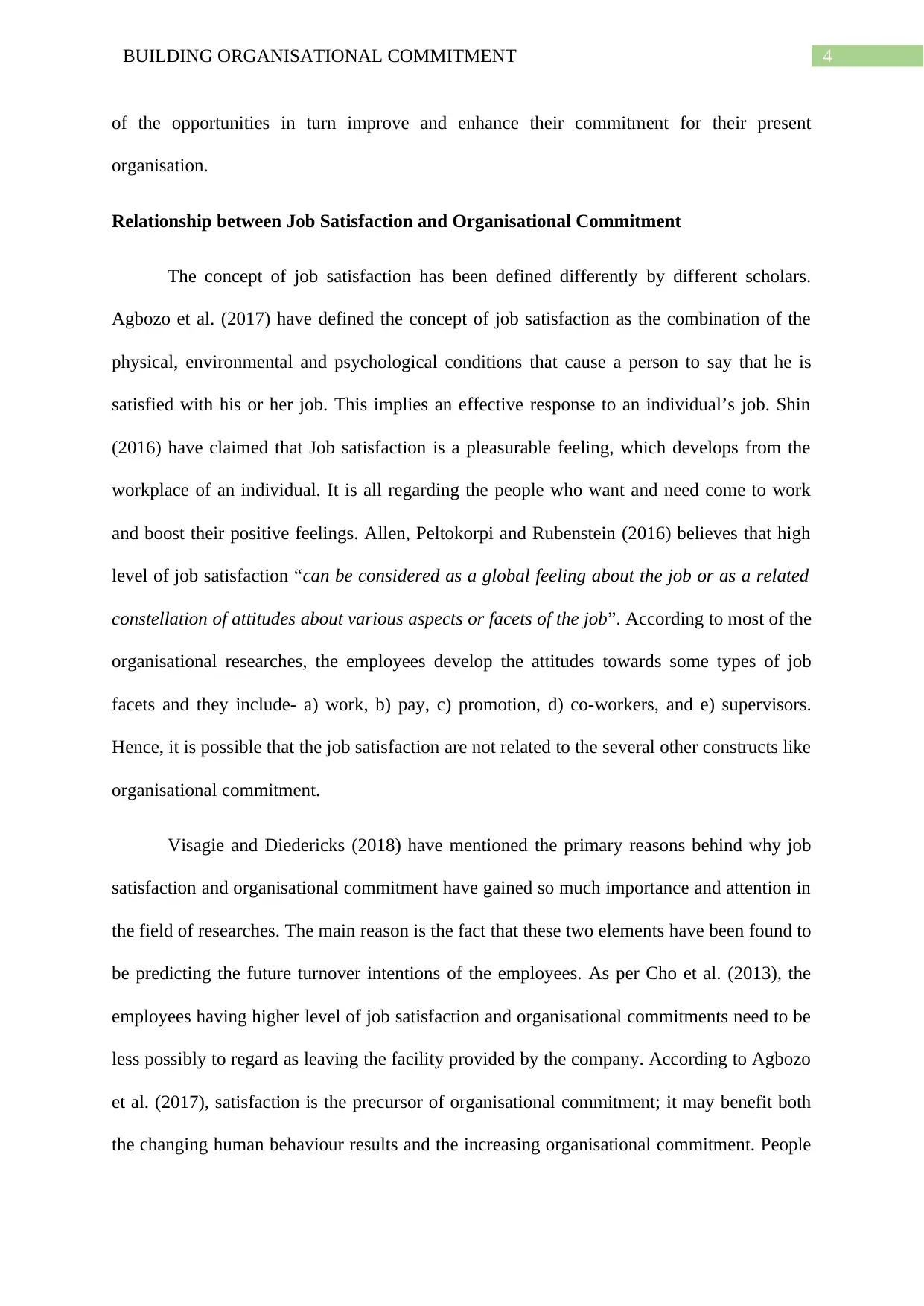
4BUILDING ORGANISATIONAL COMMITMENT
of the opportunities in turn improve and enhance their commitment for their present
organisation.
Relationship between Job Satisfaction and Organisational Commitment
The concept of job satisfaction has been defined differently by different scholars.
Agbozo et al. (2017) have defined the concept of job satisfaction as the combination of the
physical, environmental and psychological conditions that cause a person to say that he is
satisfied with his or her job. This implies an effective response to an individual’s job. Shin
(2016) have claimed that Job satisfaction is a pleasurable feeling, which develops from the
workplace of an individual. It is all regarding the people who want and need come to work
and boost their positive feelings. Allen, Peltokorpi and Rubenstein (2016) believes that high
level of job satisfaction “can be considered as a global feeling about the job or as a related
constellation of attitudes about various aspects or facets of the job”. According to most of the
organisational researches, the employees develop the attitudes towards some types of job
facets and they include- a) work, b) pay, c) promotion, d) co-workers, and e) supervisors.
Hence, it is possible that the job satisfaction are not related to the several other constructs like
organisational commitment.
Visagie and Diedericks (2018) have mentioned the primary reasons behind why job
satisfaction and organisational commitment have gained so much importance and attention in
the field of researches. The main reason is the fact that these two elements have been found to
be predicting the future turnover intentions of the employees. As per Cho et al. (2013), the
employees having higher level of job satisfaction and organisational commitments need to be
less possibly to regard as leaving the facility provided by the company. According to Agbozo
et al. (2017), satisfaction is the precursor of organisational commitment; it may benefit both
the changing human behaviour results and the increasing organisational commitment. People
of the opportunities in turn improve and enhance their commitment for their present
organisation.
Relationship between Job Satisfaction and Organisational Commitment
The concept of job satisfaction has been defined differently by different scholars.
Agbozo et al. (2017) have defined the concept of job satisfaction as the combination of the
physical, environmental and psychological conditions that cause a person to say that he is
satisfied with his or her job. This implies an effective response to an individual’s job. Shin
(2016) have claimed that Job satisfaction is a pleasurable feeling, which develops from the
workplace of an individual. It is all regarding the people who want and need come to work
and boost their positive feelings. Allen, Peltokorpi and Rubenstein (2016) believes that high
level of job satisfaction “can be considered as a global feeling about the job or as a related
constellation of attitudes about various aspects or facets of the job”. According to most of the
organisational researches, the employees develop the attitudes towards some types of job
facets and they include- a) work, b) pay, c) promotion, d) co-workers, and e) supervisors.
Hence, it is possible that the job satisfaction are not related to the several other constructs like
organisational commitment.
Visagie and Diedericks (2018) have mentioned the primary reasons behind why job
satisfaction and organisational commitment have gained so much importance and attention in
the field of researches. The main reason is the fact that these two elements have been found to
be predicting the future turnover intentions of the employees. As per Cho et al. (2013), the
employees having higher level of job satisfaction and organisational commitments need to be
less possibly to regard as leaving the facility provided by the company. According to Agbozo
et al. (2017), satisfaction is the precursor of organisational commitment; it may benefit both
the changing human behaviour results and the increasing organisational commitment. People
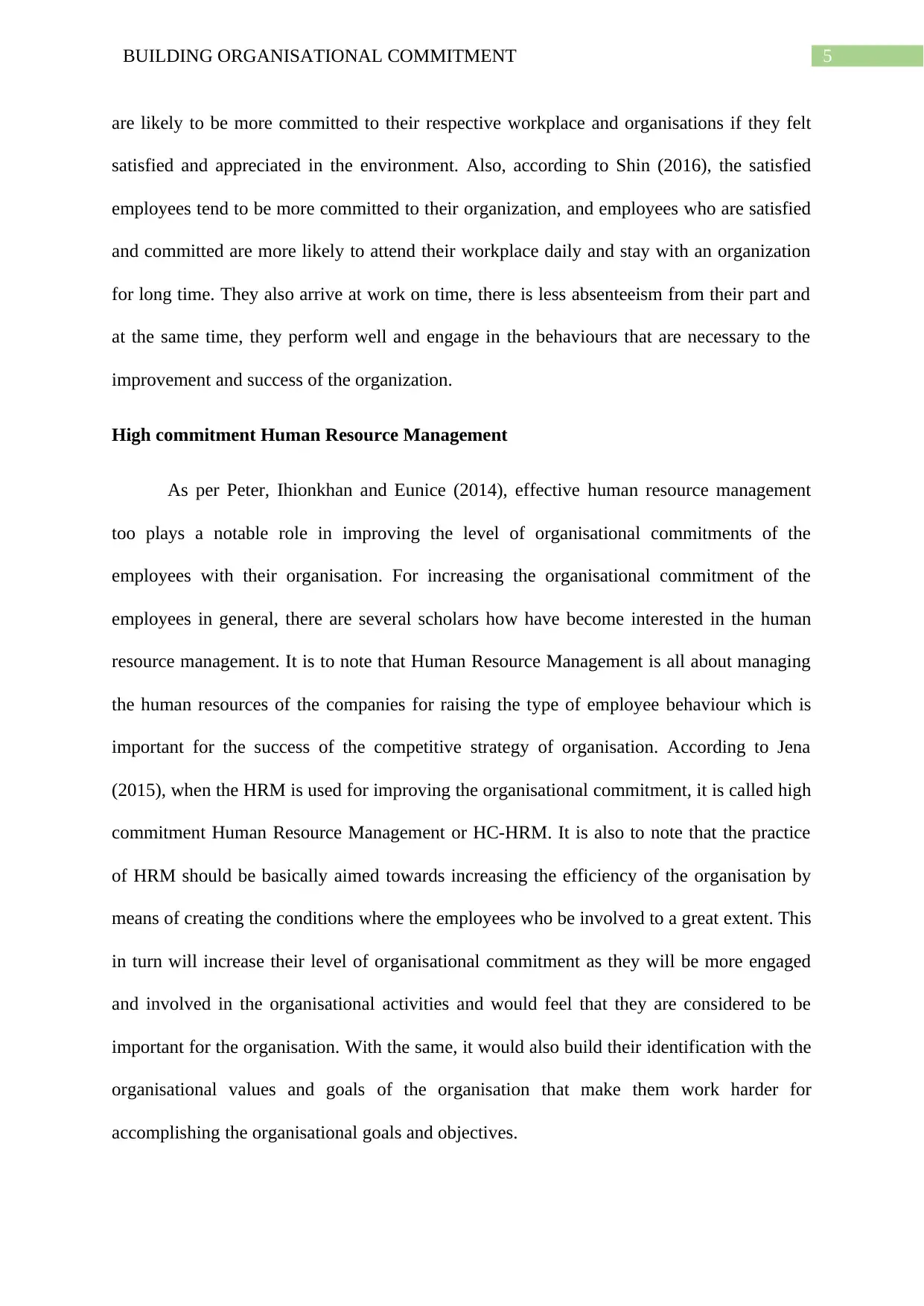
5BUILDING ORGANISATIONAL COMMITMENT
are likely to be more committed to their respective workplace and organisations if they felt
satisfied and appreciated in the environment. Also, according to Shin (2016), the satisfied
employees tend to be more committed to their organization, and employees who are satisfied
and committed are more likely to attend their workplace daily and stay with an organization
for long time. They also arrive at work on time, there is less absenteeism from their part and
at the same time, they perform well and engage in the behaviours that are necessary to the
improvement and success of the organization.
High commitment Human Resource Management
As per Peter, Ihionkhan and Eunice (2014), effective human resource management
too plays a notable role in improving the level of organisational commitments of the
employees with their organisation. For increasing the organisational commitment of the
employees in general, there are several scholars how have become interested in the human
resource management. It is to note that Human Resource Management is all about managing
the human resources of the companies for raising the type of employee behaviour which is
important for the success of the competitive strategy of organisation. According to Jena
(2015), when the HRM is used for improving the organisational commitment, it is called high
commitment Human Resource Management or HC-HRM. It is also to note that the practice
of HRM should be basically aimed towards increasing the efficiency of the organisation by
means of creating the conditions where the employees who be involved to a great extent. This
in turn will increase their level of organisational commitment as they will be more engaged
and involved in the organisational activities and would feel that they are considered to be
important for the organisation. With the same, it would also build their identification with the
organisational values and goals of the organisation that make them work harder for
accomplishing the organisational goals and objectives.
are likely to be more committed to their respective workplace and organisations if they felt
satisfied and appreciated in the environment. Also, according to Shin (2016), the satisfied
employees tend to be more committed to their organization, and employees who are satisfied
and committed are more likely to attend their workplace daily and stay with an organization
for long time. They also arrive at work on time, there is less absenteeism from their part and
at the same time, they perform well and engage in the behaviours that are necessary to the
improvement and success of the organization.
High commitment Human Resource Management
As per Peter, Ihionkhan and Eunice (2014), effective human resource management
too plays a notable role in improving the level of organisational commitments of the
employees with their organisation. For increasing the organisational commitment of the
employees in general, there are several scholars how have become interested in the human
resource management. It is to note that Human Resource Management is all about managing
the human resources of the companies for raising the type of employee behaviour which is
important for the success of the competitive strategy of organisation. According to Jena
(2015), when the HRM is used for improving the organisational commitment, it is called high
commitment Human Resource Management or HC-HRM. It is also to note that the practice
of HRM should be basically aimed towards increasing the efficiency of the organisation by
means of creating the conditions where the employees who be involved to a great extent. This
in turn will increase their level of organisational commitment as they will be more engaged
and involved in the organisational activities and would feel that they are considered to be
important for the organisation. With the same, it would also build their identification with the
organisational values and goals of the organisation that make them work harder for
accomplishing the organisational goals and objectives.
⊘ This is a preview!⊘
Do you want full access?
Subscribe today to unlock all pages.

Trusted by 1+ million students worldwide
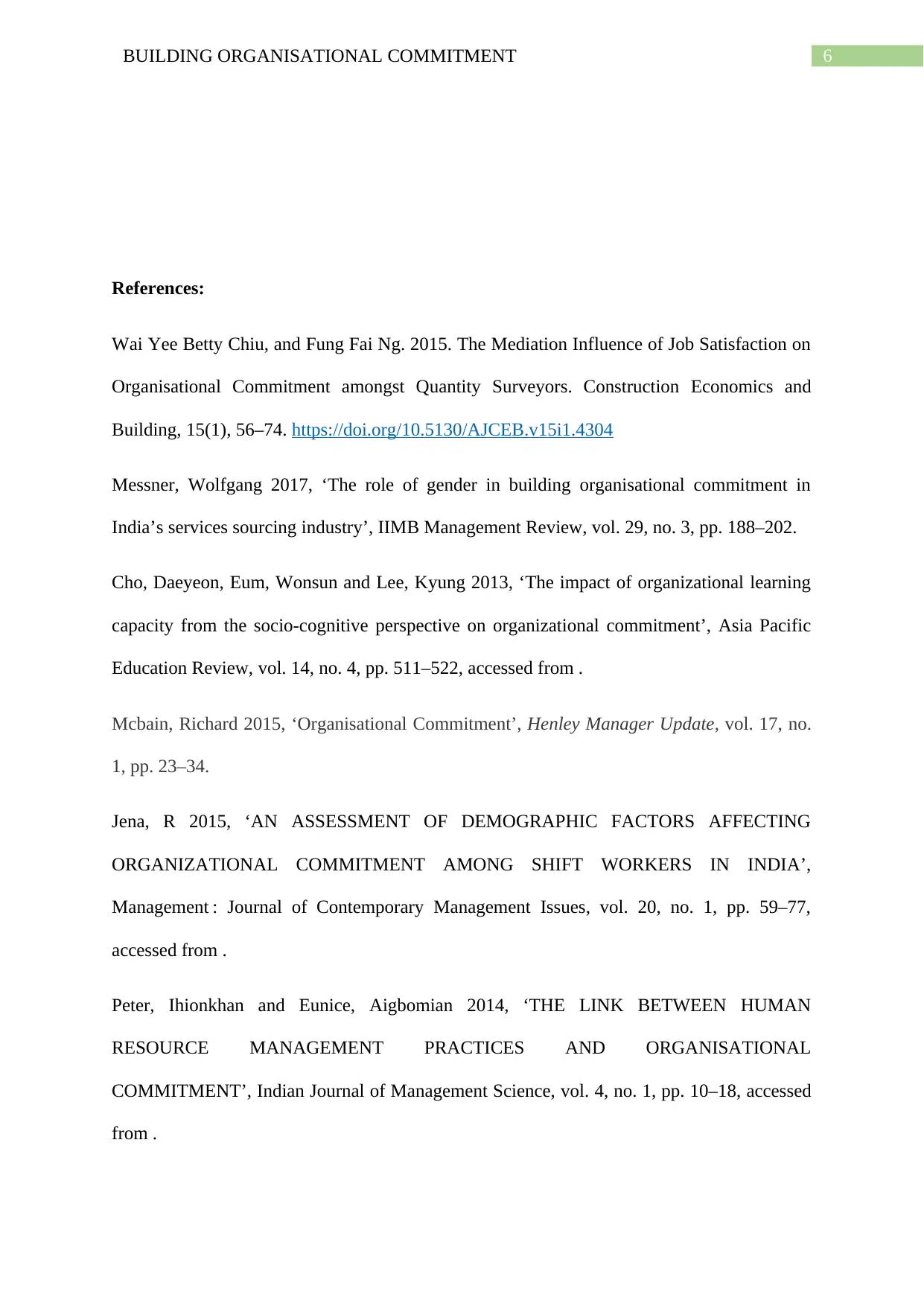
6BUILDING ORGANISATIONAL COMMITMENT
References:
Wai Yee Betty Chiu, and Fung Fai Ng. 2015. The Mediation Influence of Job Satisfaction on
Organisational Commitment amongst Quantity Surveyors. Construction Economics and
Building, 15(1), 56–74. https://doi.org/10.5130/AJCEB.v15i1.4304
Messner, Wolfgang 2017, ‘The role of gender in building organisational commitment in
India’s services sourcing industry’, IIMB Management Review, vol. 29, no. 3, pp. 188–202.
Cho, Daeyeon, Eum, Wonsun and Lee, Kyung 2013, ‘The impact of organizational learning
capacity from the socio-cognitive perspective on organizational commitment’, Asia Pacific
Education Review, vol. 14, no. 4, pp. 511–522, accessed from .
Mcbain, Richard 2015, ‘Organisational Commitment’, Henley Manager Update, vol. 17, no.
1, pp. 23–34.
Jena, R 2015, ‘AN ASSESSMENT OF DEMOGRAPHIC FACTORS AFFECTING
ORGANIZATIONAL COMMITMENT AMONG SHIFT WORKERS IN INDIA’,
Management : Journal of Contemporary Management Issues, vol. 20, no. 1, pp. 59–77,
accessed from .
Peter, Ihionkhan and Eunice, Aigbomian 2014, ‘THE LINK BETWEEN HUMAN
RESOURCE MANAGEMENT PRACTICES AND ORGANISATIONAL
COMMITMENT’, Indian Journal of Management Science, vol. 4, no. 1, pp. 10–18, accessed
from .
References:
Wai Yee Betty Chiu, and Fung Fai Ng. 2015. The Mediation Influence of Job Satisfaction on
Organisational Commitment amongst Quantity Surveyors. Construction Economics and
Building, 15(1), 56–74. https://doi.org/10.5130/AJCEB.v15i1.4304
Messner, Wolfgang 2017, ‘The role of gender in building organisational commitment in
India’s services sourcing industry’, IIMB Management Review, vol. 29, no. 3, pp. 188–202.
Cho, Daeyeon, Eum, Wonsun and Lee, Kyung 2013, ‘The impact of organizational learning
capacity from the socio-cognitive perspective on organizational commitment’, Asia Pacific
Education Review, vol. 14, no. 4, pp. 511–522, accessed from .
Mcbain, Richard 2015, ‘Organisational Commitment’, Henley Manager Update, vol. 17, no.
1, pp. 23–34.
Jena, R 2015, ‘AN ASSESSMENT OF DEMOGRAPHIC FACTORS AFFECTING
ORGANIZATIONAL COMMITMENT AMONG SHIFT WORKERS IN INDIA’,
Management : Journal of Contemporary Management Issues, vol. 20, no. 1, pp. 59–77,
accessed from .
Peter, Ihionkhan and Eunice, Aigbomian 2014, ‘THE LINK BETWEEN HUMAN
RESOURCE MANAGEMENT PRACTICES AND ORGANISATIONAL
COMMITMENT’, Indian Journal of Management Science, vol. 4, no. 1, pp. 10–18, accessed
from .
Paraphrase This Document
Need a fresh take? Get an instant paraphrase of this document with our AI Paraphraser
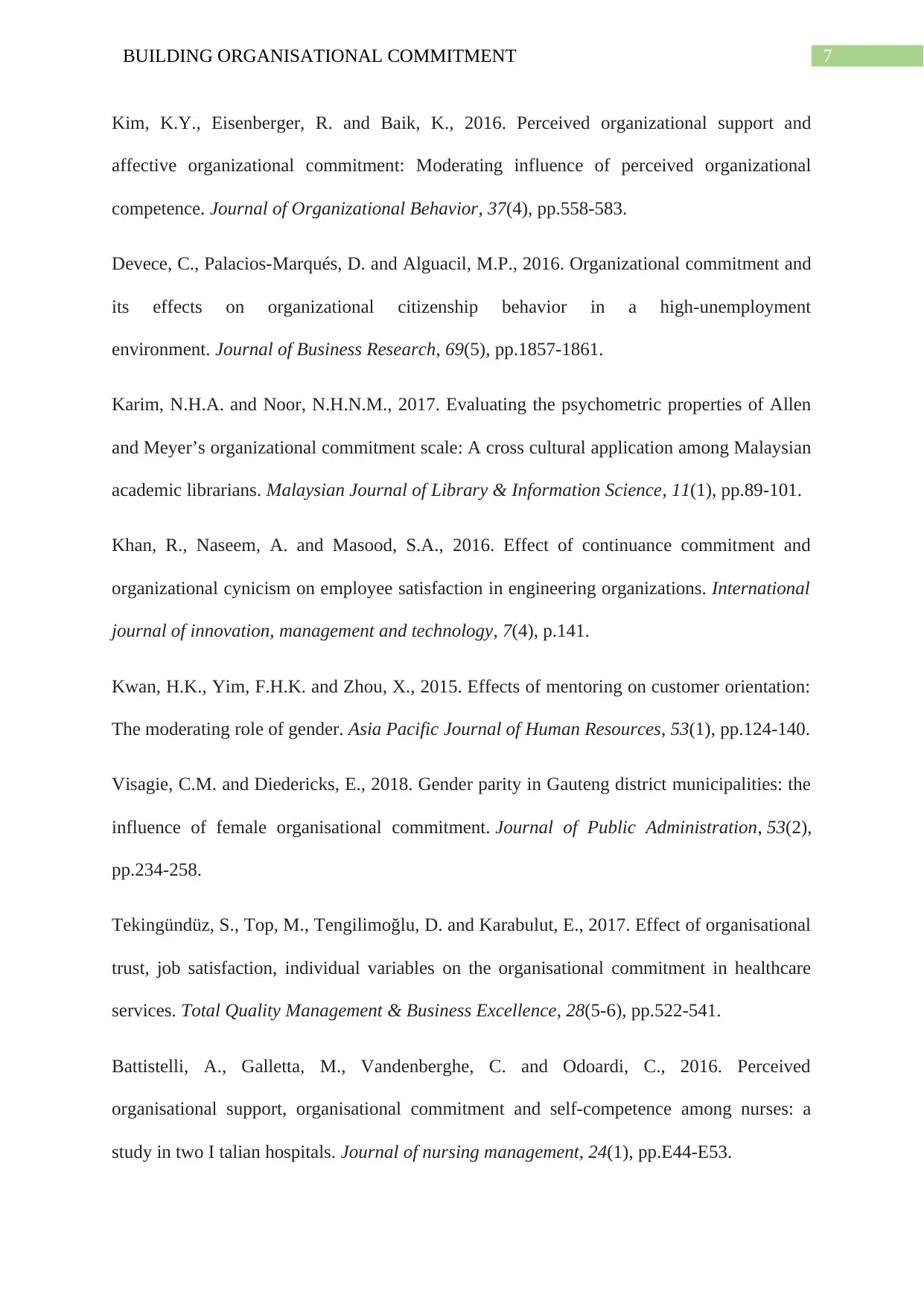
7BUILDING ORGANISATIONAL COMMITMENT
Kim, K.Y., Eisenberger, R. and Baik, K., 2016. Perceived organizational support and
affective organizational commitment: Moderating influence of perceived organizational
competence. Journal of Organizational Behavior, 37(4), pp.558-583.
Devece, C., Palacios-Marqués, D. and Alguacil, M.P., 2016. Organizational commitment and
its effects on organizational citizenship behavior in a high-unemployment
environment. Journal of Business Research, 69(5), pp.1857-1861.
Karim, N.H.A. and Noor, N.H.N.M., 2017. Evaluating the psychometric properties of Allen
and Meyer’s organizational commitment scale: A cross cultural application among Malaysian
academic librarians. Malaysian Journal of Library & Information Science, 11(1), pp.89-101.
Khan, R., Naseem, A. and Masood, S.A., 2016. Effect of continuance commitment and
organizational cynicism on employee satisfaction in engineering organizations. International
journal of innovation, management and technology, 7(4), p.141.
Kwan, H.K., Yim, F.H.K. and Zhou, X., 2015. Effects of mentoring on customer orientation:
The moderating role of gender. Asia Pacific Journal of Human Resources, 53(1), pp.124-140.
Visagie, C.M. and Diedericks, E., 2018. Gender parity in Gauteng district municipalities: the
influence of female organisational commitment. Journal of Public Administration, 53(2),
pp.234-258.
Tekingündüz, S., Top, M., Tengilimoğlu, D. and Karabulut, E., 2017. Effect of organisational
trust, job satisfaction, individual variables on the organisational commitment in healthcare
services. Total Quality Management & Business Excellence, 28(5-6), pp.522-541.
Battistelli, A., Galletta, M., Vandenberghe, C. and Odoardi, C., 2016. Perceived
organisational support, organisational commitment and self‐competence among nurses: a
study in two I talian hospitals. Journal of nursing management, 24(1), pp.E44-E53.
Kim, K.Y., Eisenberger, R. and Baik, K., 2016. Perceived organizational support and
affective organizational commitment: Moderating influence of perceived organizational
competence. Journal of Organizational Behavior, 37(4), pp.558-583.
Devece, C., Palacios-Marqués, D. and Alguacil, M.P., 2016. Organizational commitment and
its effects on organizational citizenship behavior in a high-unemployment
environment. Journal of Business Research, 69(5), pp.1857-1861.
Karim, N.H.A. and Noor, N.H.N.M., 2017. Evaluating the psychometric properties of Allen
and Meyer’s organizational commitment scale: A cross cultural application among Malaysian
academic librarians. Malaysian Journal of Library & Information Science, 11(1), pp.89-101.
Khan, R., Naseem, A. and Masood, S.A., 2016. Effect of continuance commitment and
organizational cynicism on employee satisfaction in engineering organizations. International
journal of innovation, management and technology, 7(4), p.141.
Kwan, H.K., Yim, F.H.K. and Zhou, X., 2015. Effects of mentoring on customer orientation:
The moderating role of gender. Asia Pacific Journal of Human Resources, 53(1), pp.124-140.
Visagie, C.M. and Diedericks, E., 2018. Gender parity in Gauteng district municipalities: the
influence of female organisational commitment. Journal of Public Administration, 53(2),
pp.234-258.
Tekingündüz, S., Top, M., Tengilimoğlu, D. and Karabulut, E., 2017. Effect of organisational
trust, job satisfaction, individual variables on the organisational commitment in healthcare
services. Total Quality Management & Business Excellence, 28(5-6), pp.522-541.
Battistelli, A., Galletta, M., Vandenberghe, C. and Odoardi, C., 2016. Perceived
organisational support, organisational commitment and self‐competence among nurses: a
study in two I talian hospitals. Journal of nursing management, 24(1), pp.E44-E53.
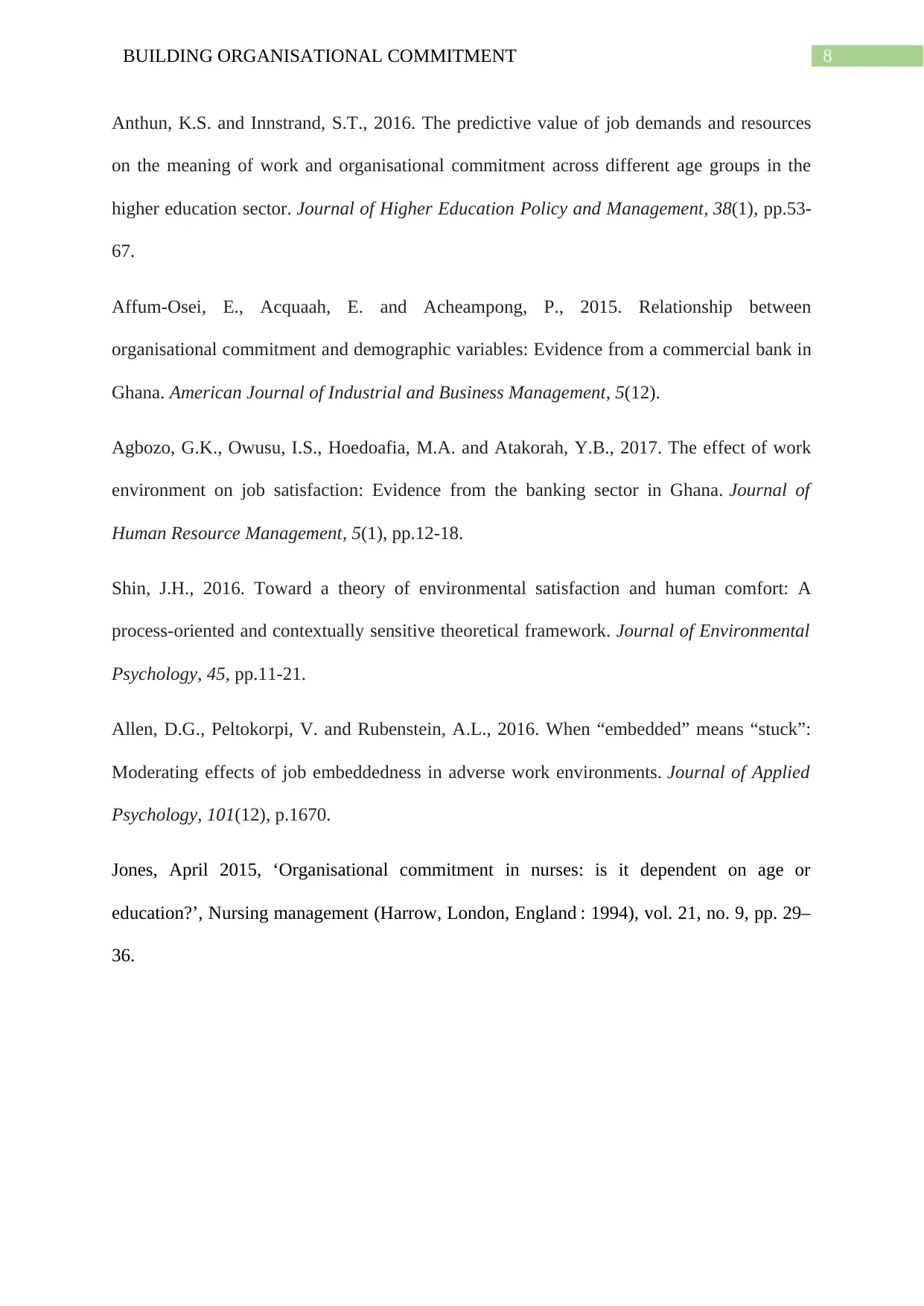
8BUILDING ORGANISATIONAL COMMITMENT
Anthun, K.S. and Innstrand, S.T., 2016. The predictive value of job demands and resources
on the meaning of work and organisational commitment across different age groups in the
higher education sector. Journal of Higher Education Policy and Management, 38(1), pp.53-
67.
Affum-Osei, E., Acquaah, E. and Acheampong, P., 2015. Relationship between
organisational commitment and demographic variables: Evidence from a commercial bank in
Ghana. American Journal of Industrial and Business Management, 5(12).
Agbozo, G.K., Owusu, I.S., Hoedoafia, M.A. and Atakorah, Y.B., 2017. The effect of work
environment on job satisfaction: Evidence from the banking sector in Ghana. Journal of
Human Resource Management, 5(1), pp.12-18.
Shin, J.H., 2016. Toward a theory of environmental satisfaction and human comfort: A
process-oriented and contextually sensitive theoretical framework. Journal of Environmental
Psychology, 45, pp.11-21.
Allen, D.G., Peltokorpi, V. and Rubenstein, A.L., 2016. When “embedded” means “stuck”:
Moderating effects of job embeddedness in adverse work environments. Journal of Applied
Psychology, 101(12), p.1670.
Jones, April 2015, ‘Organisational commitment in nurses: is it dependent on age or
education?’, Nursing management (Harrow, London, England : 1994), vol. 21, no. 9, pp. 29–
36.
Anthun, K.S. and Innstrand, S.T., 2016. The predictive value of job demands and resources
on the meaning of work and organisational commitment across different age groups in the
higher education sector. Journal of Higher Education Policy and Management, 38(1), pp.53-
67.
Affum-Osei, E., Acquaah, E. and Acheampong, P., 2015. Relationship between
organisational commitment and demographic variables: Evidence from a commercial bank in
Ghana. American Journal of Industrial and Business Management, 5(12).
Agbozo, G.K., Owusu, I.S., Hoedoafia, M.A. and Atakorah, Y.B., 2017. The effect of work
environment on job satisfaction: Evidence from the banking sector in Ghana. Journal of
Human Resource Management, 5(1), pp.12-18.
Shin, J.H., 2016. Toward a theory of environmental satisfaction and human comfort: A
process-oriented and contextually sensitive theoretical framework. Journal of Environmental
Psychology, 45, pp.11-21.
Allen, D.G., Peltokorpi, V. and Rubenstein, A.L., 2016. When “embedded” means “stuck”:
Moderating effects of job embeddedness in adverse work environments. Journal of Applied
Psychology, 101(12), p.1670.
Jones, April 2015, ‘Organisational commitment in nurses: is it dependent on age or
education?’, Nursing management (Harrow, London, England : 1994), vol. 21, no. 9, pp. 29–
36.
⊘ This is a preview!⊘
Do you want full access?
Subscribe today to unlock all pages.

Trusted by 1+ million students worldwide
1 out of 9
Related Documents
Your All-in-One AI-Powered Toolkit for Academic Success.
+13062052269
info@desklib.com
Available 24*7 on WhatsApp / Email
![[object Object]](/_next/static/media/star-bottom.7253800d.svg)
Unlock your academic potential
Copyright © 2020–2025 A2Z Services. All Rights Reserved. Developed and managed by ZUCOL.



